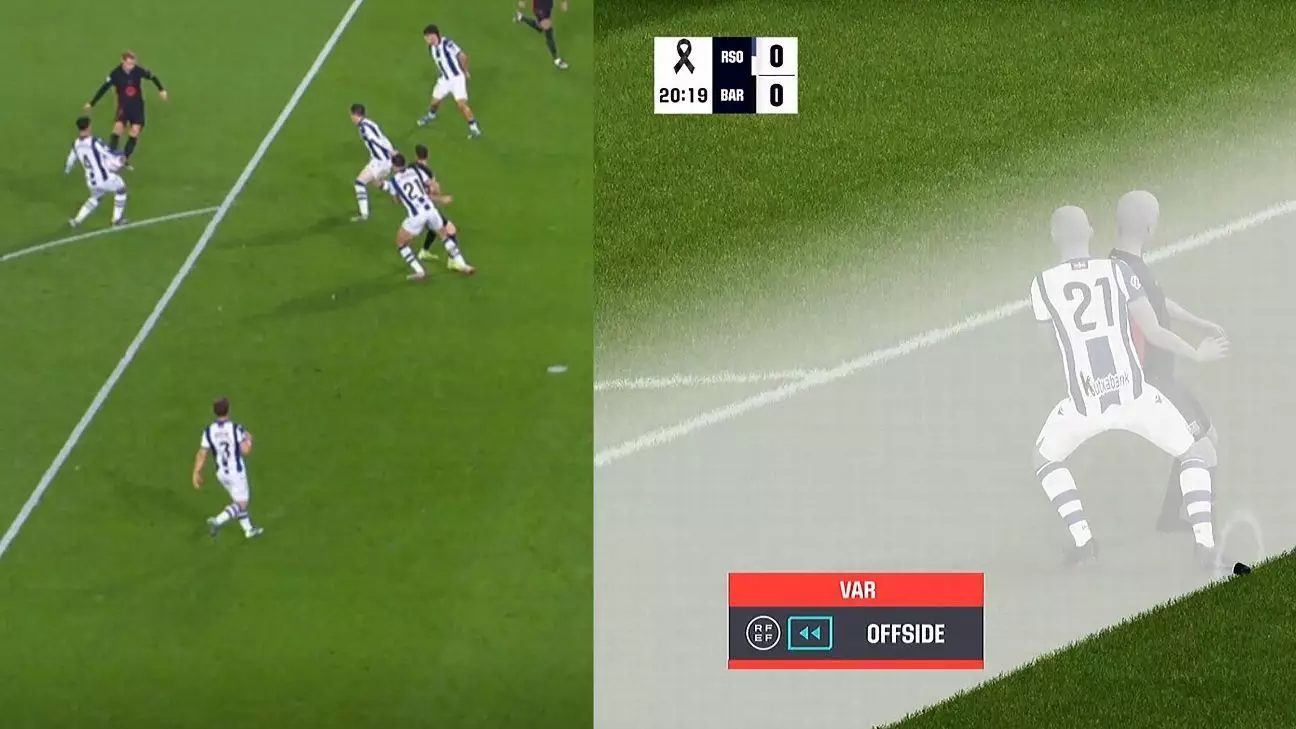In the recent La Liga match between FC Barcelona and Real Sociedad, a contentious moment overshadowed the event, reigniting discussions surrounding the use of Video Assistant Referee (VAR) technology in football. Sporting director Deco’s call for clarity following Robert Lewandowski’s disallowed goal has raised urgent questions about the efficacy of so-called semi-automatic offside technology (SAOT). The intricacies of the decision have not only left players and fans questioning the fairness of the sport but have also cast a shadow over the credibility of digital assistance in officiating.
The incident that stirred such turbulence occurred in the 14th minute when Lewandowski struck what appeared to be an opening goal, only for it to be annulled. The decision rested on SAOT determining that Lewandowski’s toe was marginally offside. The significance of details like a player’s toe being the reason for a disallowed goal speaks volumes about the current state of football technology. Hansi Flick, Barcelona’s coach, pronounced the call as “incorrect” and a “huge mistake.” The controversy is compounded by the visual evidence suggesting that Nayef Aguerd, the defender for Real Sociedad, had perhaps been in a more advantageous position at the time the pass was made by Frenkie de Jong.
While VAR was originally intended to mitigate human error in officiating, this incident raises critical questions about its actual effectiveness. Deco’s reflective inquiry into the workings of SAOT—asking if it is genuinely semi-automatic or merely reliant on human interpretation—highlights ongoing uncertainties surrounding VAR technology. His comments, emphasizing the need for an explanation, underline a growing frustration with the lack of transparency.
Deco’s exasperation illustrates a widespread sentiment among clubs and fans alike. On the one hand, the introduction of VAR aimed to eliminate contentious human decisions that have marred countless matches; on the other hand, the complexities that have emerged, such as the semi-automated aspect of SAOT, only add layers of confusion. Deco’s analogy comparing VAR’s lack of clarity to not knowing the operation of a car, whether it’s automatic or hybrid, resonates with many who experience similar frustrations in their daily lives. This feeling of being lost is further amplified when the governing bodies stand by their decisions, which makes it extremely challenging for clubs to gain resolution and clarity.
Furthermore, as VAR technology continues to evolve, discrepancies of decisions remain pervasive. As Deco pointedly noted, whether it’s Atlético Madrid, Real Madrid, or any other club, the issues stemming from VAR extend beyond Barcelona, becoming a shared concern for the integrity of the league as a whole.
The outcome of the match against Real Sociedad shocked Barcelona supporters, particularly since it was compounded by the absence of 17-year-old talent Lamine Yamal, who has yet again found himself not starting despite the team’s dire need for invention on the pitch. Deco’s mention of Yamal carries layers of significance; it connects directly to the youth’s rising importance in the squad and his comparisons to Lionel Messi, a subject likely to fill tabloids, generating both excitement and pressure.
Despite the historical weight of such comparisons, Deco dismissed any negativity associated with them as Yamal is “unique” and has embarked on his own journey within a team undergoing a significant transition. The young boy’s trajectory stands in stark contrast to Messi’s rise, yet both narratives serve to amplify the evolving identity of Barcelona as they reinvent themselves.
Ultimately, the controversy surrounding Lewandowski’s disallowed goal serves as a microcosm of broader challenges faced by football as a sport grappling with the balance of technology and traditional officiating. Deco’s insistence on requiring clearer explanations around VAR system usage could have implications that stretch beyond Barcelona; it poses critical questions that must be addressed to restore faith among players, managers, and fans alike. As football continues to innovate and integrate technology, the necessity for accountability and clarity becomes paramount—it’s time for all involved in the game to work collaboratively toward a more reliable and comprehensible officiating system. Without such mutual effort, the integrity of the beautiful game may remain precariously in limbo.

Leave a Reply